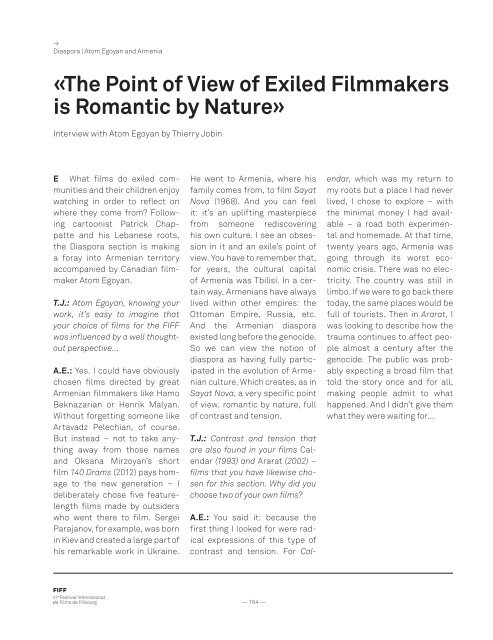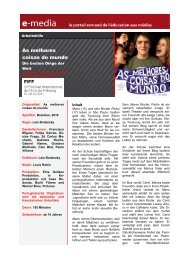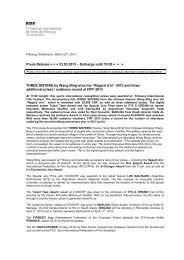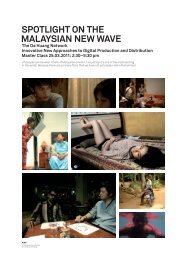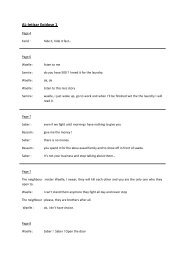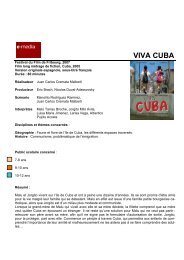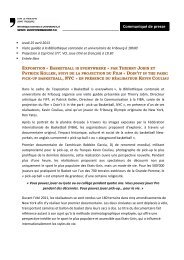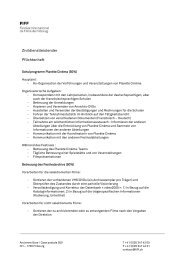Diaspora | Atom Egoyan and Armenia
Diaspora | Atom Egoyan and Armenia
Diaspora | Atom Egoyan and Armenia
Create successful ePaper yourself
Turn your PDF publications into a flip-book with our unique Google optimized e-Paper software.
→<br />
<strong>Diaspora</strong> | <strong>Atom</strong> <strong>Egoyan</strong> <strong>and</strong> <strong>Armenia</strong><br />
«The Point of View of Exiled Filmmakers<br />
is Romantic by Nature»<br />
Interview with <strong>Atom</strong> <strong>Egoyan</strong> by Thierry Jobin<br />
E What films do exiled communities<br />
<strong>and</strong> their children enjoy<br />
watching in order to reflect on<br />
where they come from? Following<br />
cartoonist Patrick Chappatte<br />
<strong>and</strong> his Lebanese roots,<br />
the <strong>Diaspora</strong> section is making<br />
a foray into <strong>Armenia</strong>n territory<br />
accompanied by Canadian filmmaker<br />
<strong>Atom</strong> <strong>Egoyan</strong>.<br />
T.J.: <strong>Atom</strong> <strong>Egoyan</strong>, knowing your<br />
work, it’s easy to imagine that<br />
your choice of films for the FIFF<br />
was influenced by a well thoughtout<br />
perspective…<br />
A.E.: Yes. I could have obviously<br />
chosen films directed by great<br />
<strong>Armenia</strong>n filmmakers like Hamo<br />
Beknazarian or Henrik Malyan.<br />
Without forgetting someone like<br />
Artavadz Pelechian, of course.<br />
But instead – not to take anything<br />
away from those names<br />
<strong>and</strong> Oksana Mirzoyan’s short<br />
film 140 Drams (2012) pays homage<br />
to the new generation – I<br />
deliberately chose five featurelength<br />
films made by outsiders<br />
who went there to film. Sergeï<br />
Parajanov, for example, was born<br />
in Kiev <strong>and</strong> created a large part of<br />
his remarkable work in Ukraine.<br />
He went to <strong>Armenia</strong>, where his<br />
family comes from, to film Sayat<br />
Nova (1968). And you can feel<br />
it: it’s an uplifting masterpiece<br />
from someone rediscovering<br />
his own culture. I see an obsession<br />
in it <strong>and</strong> an exile’s point of<br />
view. You have to remember that,<br />
for years, the cultural capital<br />
of <strong>Armenia</strong> was Tbilisi. In a certain<br />
way, <strong>Armenia</strong>ns have always<br />
lived within other empires: the<br />
Ottoman Empire, Russia, etc.<br />
And the <strong>Armenia</strong>n diaspora<br />
existed long before the genocide.<br />
So we can view the notion of<br />
diaspora as having fully participated<br />
in the evolution of <strong>Armenia</strong>n<br />
culture. Which creates, as in<br />
Sayat Nova, a very specific point<br />
of view, romantic by nature, full<br />
of contrast <strong>and</strong> tension.<br />
T.J.: Contrast <strong>and</strong> tension that<br />
are also found in your films Calendar<br />
(1993) <strong>and</strong> Ararat (2002) –<br />
films that you have likewise chosen<br />
for this section. Why did you<br />
choose two of your own films?<br />
A.E.: You said it: because the<br />
first thing I looked for were radical<br />
expressions of this type of<br />
contrast <strong>and</strong> tension. For Cal-<br />
— 164 —<br />
endar, which was my return to<br />
my roots but a place I had never<br />
lived, I chose to explore – with<br />
the minimal money I had available<br />
– a road both experimental<br />
<strong>and</strong> homemade. At that time,<br />
twenty years ago, <strong>Armenia</strong> was<br />
going through its worst economic<br />
crisis. There was no electricity.<br />
The country was still in<br />
limbo. If we were to go back there<br />
today, the same places would be<br />
full of tourists. Then in Ararat, I<br />
was looking to describe how the<br />
trauma continues to affect people<br />
almost a century after the<br />
genocide. The public was probably<br />
expecting a broad film that<br />
told the story once <strong>and</strong> for all,<br />
making people admit to what<br />
happened. And I didn’t give them<br />
what they were waiting for…
→<br />
<strong>Diaspora</strong> | <strong>Atom</strong> <strong>Egoyan</strong> <strong>and</strong> <strong>Armenia</strong><br />
T.J.: It’s a bit like recognition<br />
of the <strong>Armenia</strong>n genocide was<br />
lacking a film that produced the<br />
kind of effect of Steven Spielberg’s<br />
Schindler’s List (1993),<br />
which revealed the Holocaust to<br />
millions of Americans. And the<br />
reception of Ararat perhaps suffered<br />
because of it.<br />
A.E.: That’s exactly it. Fewer <strong>and</strong><br />
fewer people read Primo Levy or<br />
Anne Frank. The vast majority<br />
don’t go looking for images from<br />
the past either. They want what’s<br />
new. Yet that unfortunately<br />
says a lot about the true place<br />
of film <strong>and</strong> images in our society.<br />
And that’s the big problem<br />
for <strong>Armenia</strong>ns: we have neither<br />
documentary images nor words<br />
from the likes of a Primo Levy<br />
to inscribe our story on the consciousness<br />
of the 21 st century.<br />
<strong>Armenia</strong>n filmmakers know this<br />
all too well. If I’ve included two of<br />
my own films <strong>and</strong> people are surprised<br />
by that, it’s because I also<br />
want to highlight this instability<br />
– that of our memory through<br />
images.<br />
T.J.: Your colleague Robert Guédiguian<br />
must have thought<br />
about these issues. For years, he<br />
pushed off this encounter with<br />
his roots before filming <strong>Armenia</strong><br />
(2005).<br />
A.E.: It’s one of the most difficult<br />
challenges for anyone coming<br />
out of the diaspora. In Ararat, you<br />
can say that Charles Aznavour<br />
more or less embodies Henri Verneuil.<br />
Now, remember, Verneuil<br />
waited until he was 70 years old<br />
to finally allude to his <strong>Armenia</strong>n<br />
roots <strong>and</strong> the genocide. It was<br />
supposed to be the film of his<br />
career. But you can’t say that<br />
Mayrig (1991) is a masterpiece.<br />
It’s hard because a project like<br />
that almost never lives up to the<br />
expectations it provokes. Guédiguian,<br />
in my opinion, was much<br />
more successful, particularly<br />
thanks to a more direct, generous,<br />
accessible narration. Having<br />
just attempted a film in the present,<br />
past <strong>and</strong> future with Ararat<br />
– a film that takes on too much,<br />
in my opinion – I felt joy watching<br />
<strong>Armenia</strong>. I had a similar feeling<br />
watching Braden King's Here<br />
(2011), which offers, once again,<br />
a really interesting outside point<br />
— 165 —<br />
of view. A l<strong>and</strong>-mapping engineer<br />
that explores <strong>Armenia</strong> to<br />
document what remains: such a<br />
beautiful idea!<br />
T.J.: Looking at your trajectory,<br />
what’s striking is that your passionate<br />
interest today for <strong>Armenia</strong>n<br />
culture came about late in<br />
life.<br />
A.E.: I was born in Egypt <strong>and</strong> my<br />
entire family immigrated to Canada<br />
when I was two years old…<br />
On my father’s side, my gr<strong>and</strong>father<br />
<strong>and</strong> my gr<strong>and</strong>-mother<br />
were genocide survivors while<br />
my mother’s family had been living<br />
in Egypt for a longer time. But<br />
we were never Egyptian citizens.<br />
We were registered, but it wasn’t<br />
really an official document. It<br />
was only in Canada, in Victoria in<br />
British Colombia, that we finally<br />
got real identity papers.<br />
T.J.: And you first <strong>and</strong> foremost<br />
tried to assimilate to Canadian<br />
culture at all costs.<br />
A.E.: That was my whole life. Until<br />
I turned 18. That’s when I arrived<br />
in Toronto for school. And<br />
when I discovered at that I didn’t
→<br />
<strong>Diaspora</strong> | <strong>Atom</strong> <strong>Egoyan</strong> <strong>and</strong> <strong>Armenia</strong><br />
know anything about a whole<br />
part of my history. That literally<br />
overwhelmed me.<br />
T.J.: Until that point there hadn’t<br />
been any expression in your family<br />
about its origins?<br />
A.E.: Of course there had been.<br />
We had books about painting,<br />
in particular. My parents loved<br />
painting <strong>and</strong> painted in their<br />
free time. So I was very aware of<br />
my family’s cultural side. What I<br />
wasn’t aware of, was the historical<br />
context or the importance of<br />
the church.<br />
T.J.: What clicked for you in Toronto<br />
that you suddenly had this<br />
thirst to know about your <strong>Armenia</strong>n<br />
roots?<br />
A.E.: At university, the Anglican<br />
chaplain, Harold Nahabedian,<br />
was actually a converted <strong>Armenia</strong>n<br />
priest. He allowed me<br />
to learn everything: to read, to<br />
write, to underst<strong>and</strong> the history…<br />
T.J.: Why didn’t your father manage<br />
to fill this role when you were<br />
younger?<br />
A.E.: Because Nahabedian had<br />
stayed passionate about <strong>Armenia</strong>.<br />
My father had a different experience.<br />
When he was young, he<br />
was lucky enough to study at the<br />
Chicago Art Institute. He found<br />
himself surrounded by abstract<br />
<strong>and</strong> impressionist thought. And<br />
when he came back, he was<br />
shocked by the feedback from<br />
the <strong>Armenia</strong>n community in Cairo:<br />
why go so far away to learn to<br />
paint like a child?! After which his<br />
relationship with his <strong>Armenia</strong>n<br />
roots became complicated. Extremely<br />
complicated. In the ’70s,<br />
he went to <strong>Armenia</strong> <strong>and</strong> in front<br />
of the monument dedicated to<br />
the genocide victims, the Tsitsernaskaberd<br />
in Yerevan, he literally<br />
collapsed. He sometimes talks<br />
about what happened, saying it<br />
was as if the ghosts of the past<br />
overcame him. As if all his years<br />
of denial came back to him with<br />
violence. I remember it so well:<br />
he returned to Canada completely<br />
changed. Now he cries<br />
when he hears, in Ararat, one of<br />
the songs that his mother used<br />
to sing to him.<br />
— 166 —


